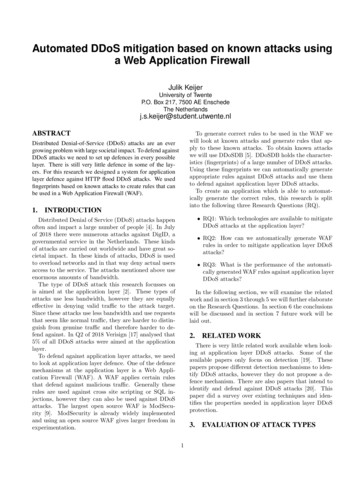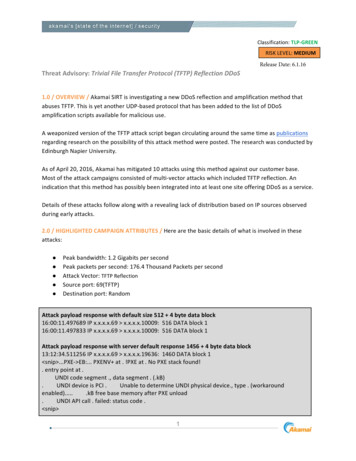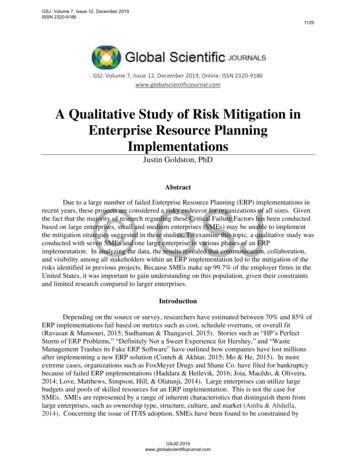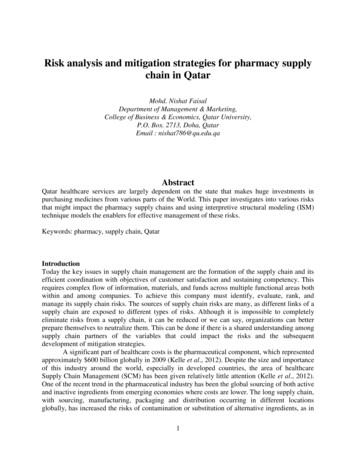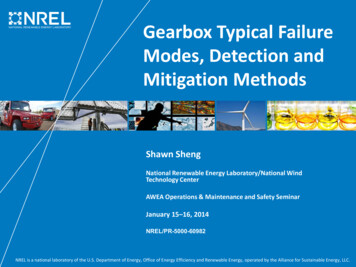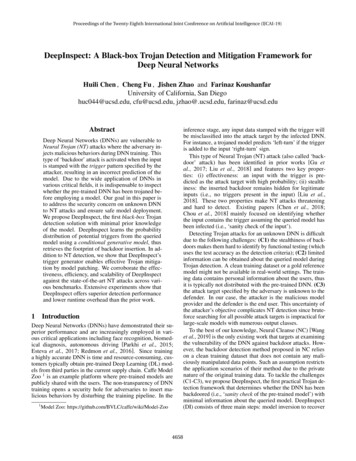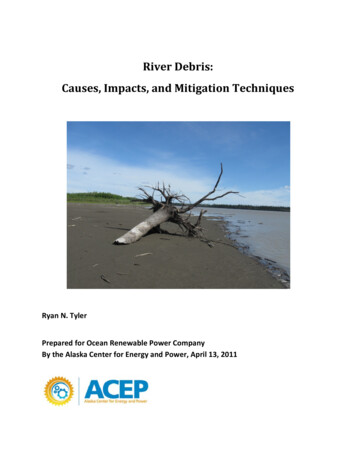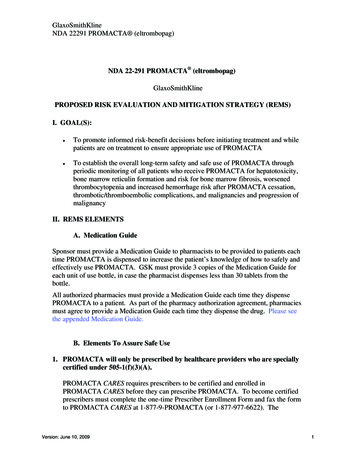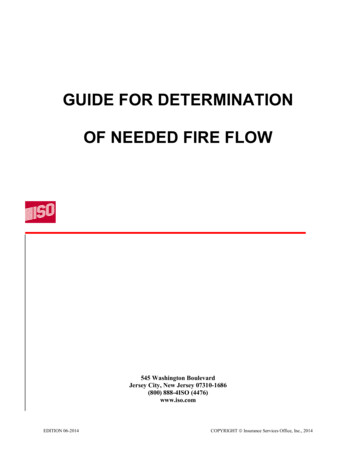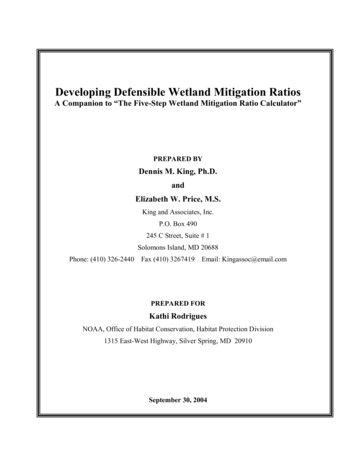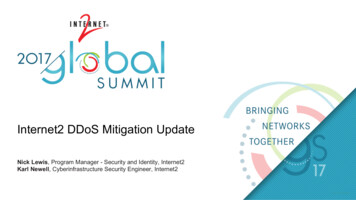
Transcription
Internet2 DDoS Mitigation UpdateNick Lewis, Program Manager - Security and Identity, Internet2Karl Newell, Cyberinfrastructure Security Engineer, Internet2 2016 Internet2
Let’s start with questions! How many campuses have experienced a DDoS attack? What kind of attack? Volume? How long did it last and what was the impact? How did you remediate the attack? How did you engage your transit provider? When you get asked about what your DDoSstrategy, what do you respond with?[2]
Background on DDoS Attacks What is a DDoS attack?– A distributed denial-of-service (DDoS) attack is an attack in which multiplecompromised computer systems attack a target, such as a server, website orother network resource, and cause a denial of service for users of the targetedresource. Why perform a DDoS attack? There isn't just one way to deal with DDoS attacks and there isn't just oneprovider that can effectively defend our members. Rather it takes a variety ofsolutions engaged through different providers to thwart large-scale attacks.[3]
DDoS Attack Basics Volumetric attacks clog the circuits, delivering information by sending morepackets than the circuit can process, thereby saturating the circuit andmaking services unavailable. Application layer attacks are focused on rendering applications such asweb servers unavailable by exhausting web server resources. These attacksdo not have to consume all of the network bandwidth to be effective. Ratherthey place an operational strain on the application server in such a way thatthe server becomes unavailable. Multi-vector attacks tend to run over an extended period of time andengage different attack methods intended to evade detection and mitigationefforts while maximizing the damage to the victim.[4]
DDoS Attacks In 2000, DoS attacks made big news when major websites like CNN, Yahooand Ebay went offline because of DoS attacks. The DDoS threat history is chronicled in a Fortinet blog post.–Early 2000’s - Emerging awareness– 2005 - monetization of DDoS– 2010 - Hacktivism– 2012 and beyond - Application level attacks emerging[5]
Trends in DDoS – Past Attacks2013 -120Gbps Spamhaus attack2014 – 400Gbps NTP amplificationattack on a web serverReflection, using spoofed IP addresses andvulnerable recusors to point DNS, NTP, orother traffic to a target, has been a commonattack vector.Cloudflare has been fighting historicDDoS attacks for over 5 years. Backin 2013, the 120Gbs on Spamhauswas a “big” attack, and we were ableto keep their website online.DDoS attacks take all shapes andforms. In this 400Gbps amplificationattack, an attacker used 4,529 NTPservers to amplify an attack from amere 87Mbps source server.Source: CloudFlare presentation toSecurity Working Group[6]
Current DDoS Attacks Brian Kreb DDoS and investigation– pai-the-mirai-worm-author/ Dyn DDoS– october-21-attack/ Mirai botnetSource: CloudFlare presentation toSecurity Working Group[7]
DDoS Mitigation Options On-prem systems– Arbor, Radware, F5, and many others Filtering sources–Router ACLs, firewalls, IPS, other network devices– Blackhole routing Cloud services– CDN– Cloud scrubbing– AWS Shield - https://aws.amazon.com/shield/ BCP38 - https://tools.ietf.org/pdf/bcp38.pdf[8]
ations/DDoS%20Quick%20Guide.pdf[9]continued.
ations/DDoS%20Quick%20Guide.pdf[ 10 ]
Deepfield Categorized DDoS[ 11 ]
Internet2 DDoS Mitigation Strategy Multi-faceted approach Mitigation of volumetric attacks– Network filtering - blackholing, flowspec– Cloud scrubbing– On-prem appliances Mitigation of application layer attacks– On-prem appliances– Cloud based protection[ 12 ]
Internet2 Mitigation Currently BGP blackhole– Drops traffic destined for a host– Completes the attack Cloud-based DDoS scrubbing service[ 13 ]
Security Working Group engagement Presentations from DDoS mitigation vendors– A10, Akamai, Arbor, Cloudflare, Deepfield, Imperva Developed technical requirements for RFP Scored RFP responses[ 14 ]
Internet2 DDoS Mitigation Service Partner with Zenedge Currently in pilot General availability July 1, 2017 Direct traffic to scrubbing center - more specific BGP announcement Return clean traffic via VLAN on Internet2 backbone– Shared 10G clean traffic (40G of physical capacity)– Subscriber gets 1G commit and can burst to 10G Unlimited IPv4/IPv6 assets Unlimited mitigations Access to portal and SOC[ 15 ]
Diverted attack trafficCommodity trafficClean traffic return pathProtecting commodity tworkSubscriberTenant
Protecting Research and Education trafficScrubbingCenterDiverted attack trafficResearch and Education trafficClean traffic return pathInternet2NetworkRegional/Member[ 17 ]NetworkSubscriberTenant
Future Internet2 DDoS Mitigation Strategy Deepfield Defender - network attack detection BGP Flowspec––––“BGP signaled ACLs”Granular packet matchingCan block sourcesWeb based portal NET service(s) for application protection IoT Systems Risk Management Task Force– https://er.educause.edu/ /media/files/articles/2016/6/erm1649.pdf Suggestions?[ 18 ]
NET DDoS Mitigation Closely internally coordinating Talked with several DDoS mitigation providers– Akamai, BlackLotus (Acquired by Level3), Cloudflare, Zenedge Baylor suggested working with CloudFlare and is closest to potential service Akamai has engaged with us several times and has several higher edcustomers[ 19 ]
CloudFlare NET discussions as part of new cloud discovery service They are helping us developed the business processes around new clouddiscovery service Starting slow and as campuses sign-up, develop more integrations Engaged on technical aspects– InCommon, Network, Security[ 20 ]
Cloudflare DDoS Protection for Web Applications WAF, Rate Limiting, CDN, DNS (optional) In Use by Baylor University and 8 other universities in the U.S.– Baylor.edu hit by DDoS attack in May 2016– Cloudflare onboarded baylor.edu in several hours and stopped attacks– Cloudflare attack prevention is always on-line, no need for manual monitoring– Baylor team is happy with Cloudflare’s effectiveness and ease of management– Today Cloudflare protects 11 Baylor public facing websites– Cloudflare stopped 72k threats against baylor.edu last month[ 21 ] 2016 Internet2
How CloudFlare DDoS Mitigation works Each Cloudflare customer IP address isannounced, using anycast, from each datacenter in our network. BGP routes incomingtraffic to the closest data center. This prevents DDoS attackers from targeting aspecific data center, and distributes attacktraffic. Attacks across DNS, L3/L4, and L7 targetingDNS and web applications are detecteddirectly from our routers, and automaticallymitigated. This lets us act quickly against evenhuge attacks. 10 Tbps capacity stops the largest attacks.Our Global Anycast Network
Let’s Finish With Questions! Any questions? Any suggestions? What’s your interest in the Internet2 DDoS MitigationService? Potential NET service with CloudFlare? Do you have DDoS mitigation documentation? (Plan, policy,procedure, etc) If you don’t have one, would it be helpful if we drafted anoutline to go with what we are developing? Where do you see Internet2 fitting into your DDoS strategy? How do you see an Internet2 DDoS mitigation strategyfitting in with the community?[ 23 ]
Contact InformationNick Lewis nlewis@internet2.edu Karl Newell knewell@internet2.edu References Link to blog tp://www.internet2.edu/blogs/detail/13507 ations/DDoS%20Quick%20Guide.pdf CloudFlare presentation to Security Working ction?pageId 93651521&preview 20DDoS%20Presentation%20v4%5B1%5D.pptx[ 24 ]
May 03, 2017 · – A10, Akamai, Arbor, Cloudflare, Deepfield, Imperva Developed technical requirements for RFP Scored RFP responses [ 15 ] Internet2 DDoS Mitigation Service Partner with Zenedge Currently in pilot General availability July 1, 2017 . Access to portal and SOC. Com
